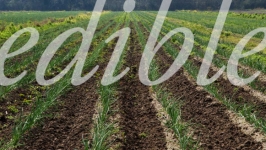Feel Good Writing: How to Enjoy Your Harvest Longer
By Dean Volenberg and Jenny Spude, UW Extension Specialists
Imagine serving home-grown carrots, crisp Door County apples and other fruits and vegetables on a New Year’s Eve party platter. Yes, it is possible to store some fruits and vegetables until almost spring. The trick is to pay attention to harvest and post-harvest, handling and storage. While our Wisconsin growing season is short, it’s what we do after the harvest that determines how long our harvest can be enjoyed.
The crops you intend to store need to be free of insect, disease and mechanical damage. Take the time to sort through your crops before storing. Crops which are damaged can be used immediately.
Fruits and vegetables continue living even after harvest and this impacts how they should be stored. Once fruits and vegetables are harvested they no longer continue to grow but they do continue to respire. The respiration process, regardless of whether we are talking about a human or a vegetable, byproducts include heat, carbon dioxide and water vapor.
The goal of post-harvest handling and storage is to slow respiration in fruits and vegetables. When fruits and vegetables are stored at the correct temperature, respiration is slowed and the shelf-life is extended.
Only store fruits and vegetables that are clean and dry. If possible harvest root crops when the soil is dry. For root crops, such as beets, carrots, potatoes and parsnips gently remove the soil being careful not to mechanically damage the skin. Most all micro- organisms that cause rot need moisture and a point of entry such as a wound to cause infection. For fruits such as apples, simply make sure they are dry and free of insect damage or disease before storing.
Here are the basics on storing over the winter season:
Cool and Dry: 50-60 degrees, 60% relative humidity. Think your basement or attached garage. Cool and dry is best for storing winter squash and pumpkins.
Cold and Dry: 32-40 degrees, 65% relative humidity. Consider your refrigerator or warm area in your unattached garage. Cold and dry is best for storing onions and garlic.
Cold and Moist: 32-40 degrees, 95% relative humidity. This storage environment is hard to recreate. Most often it should be a refrigerator for the cold temperature, but to create the proper humidity, storing produce in a plastic bag is imperative.
Cold and moist is best for most fruits and tender vegetables.
If you do not have suffi cient refrigerator room to create your ideal “cold and moist” environment, consider storing root crops in a trench within the garden. Dig a trench about one foot deep and line it with three inches of straw. Place the root crops on the straw and cover them with one foot of straw and three inches of soil. The goal of trench storage is to protect the vegetables from extreme cold and at the same time provide you access to the vegetables. Trench storage will typically provide you with storage into late December. As a reminder, check on your stored food supply to periodically remove softening, shrinking or decaying vegetables.
Consider storing more of your harvest this year. It’s a rewarding part of growing your own food. A few extra months of not buying root vegetables or fruits also stretches food dollars. The last and best bonus is time savings! Harvesting carrots from the garden trench to add into a packed lunch or into your pot of soup or Thanksgiving stuffi ng saves more than a few trips to the grocery store.
Have a healthy, fruitful, happy Holiday season.
More information visit learningstore.uwex.edu








